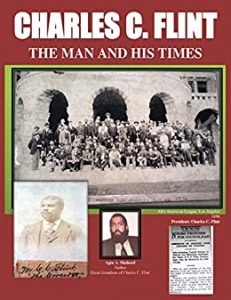By: Agin A. Shaheed

Taken from the book, “Charles C. Flint The Man And His Times,” this profile of Mr. Flint frames and offers a glimpse into the business climate of early Black Los Angeles.
Black business turn of the century Los Angeles in a Liberator newspaper article recognizes Charles C. Flint as, “the oldest businessman of our race.” Over the years C. C. Flint was President of The Colored Business Men’s Association, located 252 ½ So. Main Street. Flint was President of The Southern Ca. Real Estate & Investment Co. 1027 Sante Fe Ave. Shares were available in 1905. Flint was a member of the, “United Order of True Reformers,” verified by a 1906 stock certificate. The Colored Voters Independent League was formed with Flint as its first President.
The 1890 census identified a Black population of 1,258. A business card for Lealand and Flint
Second Hand Goods, 626 Upper Main is a part of the Flint collection of artifacts. As early as
1888 as referenced by “Neimores Southern California Guide, Black businesses were existing on
San Pedro street who local residents called the “Brick Block.” By 1920 the movement stopped.
By 1906 Flint owned a grocery store located 1101 Sante Fe Avenue, in the downtown
metropolitan Los Angeles District. Among the Blacks who came to the city with revenue and
savings, they found business opportunities unrestricted in early Los Angeles. Yet another store
location opened by Flint in 1913 at 3321 Hooper Avenue, heralds the black entrepreneur push
towards the eventual Central Avenue corridor of Businesses. May 26, 1908 Charles C. Flint is
appointed to the Board of Los Angeles Industrial School, who is aided by Booker T. Washington.
The board is augmented by a number of White businessmen who are interested in the project.
Republic district committeeman in the campaign of 1896, Vice President of the State League
1897, and a delegate to the Silver Republican Convention 1900 Flint led the Black voting
community to leverage business and social employment in the City. By 1910 with a population of
7,599 Los Angeles Blacks had the highest percentage of home ownership in the Nation of 37%,
in contrast to 10% in other cities.
A 2015 Los Angeles Times newspaper article, “Black politics 1913,” cites Charles C. Flint as
the leading contender for a City Council position against White opponent Wesley J. Bryant. The
Black social and Business community had become strong enough to create a platform for its
equal share of the distribution of wealth. 15,000 Negro voters gained the attention of the Cities
political landscape. Shifting from Republican to Democratic, Flint and the voting business and
working class Black population, espoused the perspective that they should retain an open
posture of voting for the party that promoted social and business outcomes for the growing
population that by 1922 had grown to 15,597. These early pioneers laid the foundation for the
eventual golden era of Mayor Tom Bradley’s twenty one year progress in business and social
gains for its Black population. As an Ambassador for The South Los Angeles Chamber of
Commerce, which is dedicated to continuing the growth of historical Black and other vibrant
ethnic communities of Los Angeles business and social progress, this article profiling my
Greatgrandfather Charles C. Flint, offers the recognition of often unsung heroes of civic life.
Agin A. Shaheed
Agin Shaheed
Area Ambassador L.A. South Chamber of Commerce
(619) 787 -3047 | aagin7@aol.com

Recent Comments